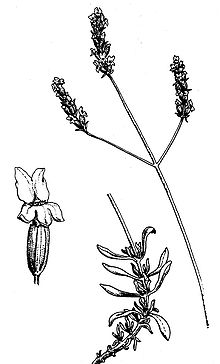| Lavandula latifolia Spike lavender | |
|---|---|

| |
| Conservation status | |
 Least Concern (IUCN 3.1) | |
| Scientific classification | |
| Kingdom: | Plantae |
| Clade: | Tracheophytes |
| Clade: | Angiosperms |
| Clade: | Eudicots |
| Clade: | Asterids |
| Order: | Lamiales |
| Family: | Lamiaceae |
| Genus: | Lavandula |
| Species: | L. latifolia |
| Binomial name | |
| Lavandula latifolia Medik. | |
| Synonyms | |
| |

Lavandula latifolia, known as broadleaved lavender, spike lavender, aspic lavender or Portuguese lavender, is a flowering plant in the family Lamiaceae, native to the western Mediterranean region, from central Portugal to northern Italy (Liguria) through Spain and southern France. Hybridization can occur in the wild with English lavender (Lavandula angustifolia).
The scent of Lavandula latifolia is stronger, with more camphor, and more pungent than Lavandula angustifolia scent. For this reason the two varieties are grown in separate fields.
Description
Lavandula latifolia is a strongly aromatic shrub growing to 30–80 cm tall. The leaves are evergreen, 3–6 cm long and 5–8 mm broad.
The flowers are pale lilac, produced on spikes 2–5 cm long at the top of slender, leafless stems 20–50 cm long. Flowers from June to September, depending on weather.
The fruit is a nut, indehiscent, monosperm of hardened pericarp. It consists of 4 small nuts which often remain locked inside the calyx tube. Grows from 0 to 1,700 m amsl.
Etymology
The species name latifolia is Latin for "broadleaf". The genus name Lavandula simply means lavender.
Chemical composition
- Camphor (10.8–23.2%)
- Eucalyptol (28.0–34.9%)
- Borneol (0.9–3.6%)
- α-Pinene(? %)
- β-Pinene(0.8–2.6%)
- Caryophyllene (0.5–1.9%)
- Camphene(0.4–0.6%)
- Guaiazulene (? %)
- Linalool (27.2–43.1%)
- Geraniol (? %)
- Limonene (0.2–0.9%)
Uses
Lavandula latifolia can be used in aromatherapy.
References
- Khela, S. (2013). "Lavandula latifolia". IUCN Red List of Threatened Species. 2013: e.T203245A2762556. doi:10.2305/IUCN.UK.2013-2.RLTS.T203245A2762556.en. Retrieved 23 January 2024.
- "Sinonimia en Tela Botánica". Archived from the original on 2011-07-19. Retrieved 2011-01-17.
- NRCS. "Lavandula latifolia". PLANTS Database. United States Department of Agriculture (USDA). Retrieved 23 January 2016.
- Bolòs and Vigo Flora dels Països Catalans Barcelona 1990
- ^ Salido, Sofía; Altarejos, Joaquín; Nogueras, Manuel; Sánchez, Adolfo; Luque, Pascual (May 2004). "Chemical Composition and Seasonal Variations of Spike Lavender Oil from Southern Spain". Journal of Essential Oil Research. 16 (3): 206–210. doi:10.1080/10412905.2004.9698698.
- "Lavandula latifolia Spike Lavender, Broadleaved lavender PFAF Plant Database". pfaf.org. Retrieved 2020-10-06.
Bibliography
- Blumenthal M, Goldberg A, Brinckmann J. Herbal Medicine, Expanded Commission E Monographs. Integrative Medicine Communications, Newton. First Edition, 2000.
- Grases F, Melero G, Costa-Bauza A et al. Urolithiasis and phytotherapy. Int Urol Nephrol 1994; 26(5): 507–11.
- Paris RR, Moyse H. Matière Médicale. Masson & Cia., Paris; 1971. Tome .
- PDR for Herbal Medicines. Medical Economics Company, Montvale. Second Edition, 2000.